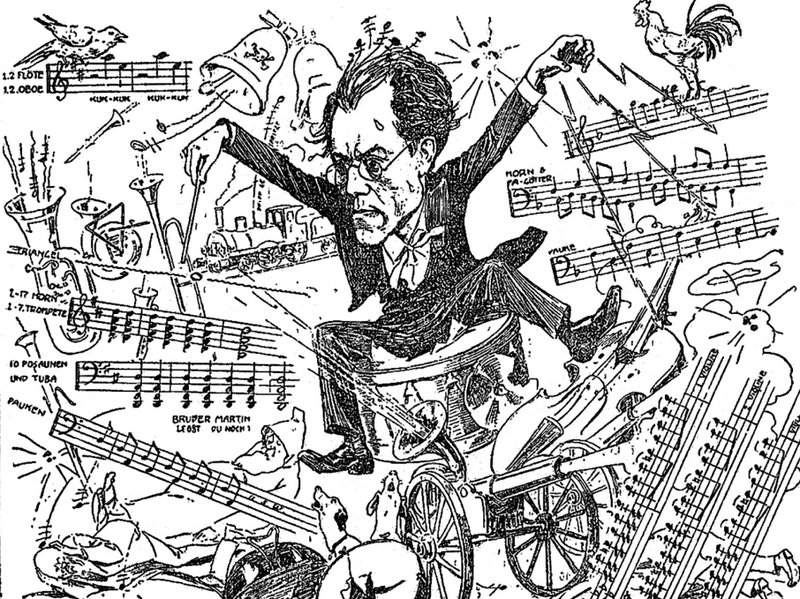A newly-released Critical Edition of Mahler’s First Symphony reveals that the composer made major changes to the work following its final performances in New York in 1910 and that musicians, for the last 100+ years, have been playing the work completely wrong.

A picture of the ‘Carnegie Klusterficken’ when Mahler conducted his First Symphony for the last time
Newly discovered research shows that Mahler’s final performance of the work was something of a disaster. “We now know that at the final performance under Mahler’s baton, when the horns stood up at the end, the fifth hornist knocked over the tam tam,” writes Christoph Pedant, editor-in-chief at Brechenauf und Chörtle, publishers of the new Critical Edition. “This launched a chain reaction, with the tam tam taking out the bass drum, which knocked over cymbals. The poor horn player was so startled that he lurched forward and flipped over the shoulder of the e-flat clarinet player and took out most of the flutes. The principal clarinettist’s instrument flew up in the air and wedged itself inside the bell of the principal trumpeter. Mahler carried on as bravely as he could, but in all the commotion it became apparent that the second timpanist had not put the brakes on his drums and Mahler’s final performance of his own music in New York ended with two timpani rolling downstage and into the auditorium of Carnegie Hall.”
Mahler was said to be “somewhat disappointed” with the performance, although New York critics were still more positive about his music than the Viennese press had been. Nevertheless, he quickly arranged another concert to feature the First Symphony, but planned on a drastic revision.
“Following what has since become known as the ‘Carnegie Klusterficken,’ Mahler had serious doubts about the viability of the finale,” says Pedant.
“It was after a long night drinking schnapps with Bruno Walter that a solution was found. Walter suggested that Mahler should re-arrange the movements of the First Symphony.” The next afternoon Mahler, suffering a monumental hangover, wrote in the margin of his score, using what appears to have been one of his wife’s eye pencils: “Die zweite erste, die erste dritte und die letzte gar nicht” (“The second first, the first third, and the last not at all”).
Also at Walter’s suggestion, Mahler restored ‘Blumine,’ the “modestly attractive” piece of theatrical scene-change music he had cut from the original five-movement version of the work several years earlier, as the finale of the work. The new, official order of the symphony’s four sanctioned movements is now:
I. Scherzo
II. Funeral March
III. Old First Movement
IV. Blumine
Conductor Kevin DuBois of the Kentucky MahlerFeast, who leads the world première performance of the new version of Mahler’s First Symphony on April 1st , says the new discovery marks a major breakthrough in Mahler scholarship. “News that we’ve been not only been playing the movements in the wrong order, but actually playing the wrong movements, has generated more free publicity for everyone than anything I’ve been involved in since we premièred the sketches for an 11th Beethoven Symphony recovered from a napkin Beethoven scribbled them on in a sausage house in suburban Vienna.”
“Walter was one of Mahler’s most trusted advisers,” says Pedant. “He not only convinced Mahler to reverse the inner movements of the Sixth Symphony after getting him completely hammered on heuriger Wein in Gumpoldskirchen, he also did Mahler the great favour of introducing his wife Alma Mahler to Walter Gropius. He was always looking out for Mahler, and wasn’t jealous of Mahler at all.”
“Following his drunken conversation with Bruno Walter, Mahler never conducted the First again in any other order other than the one we have published here,” says Pedant. “This means we can be absolutely certain that he never sobered up and realised he’d done something absolutely bonkers.”
The new edition of the First Symphony also clarifies long-standing debate over the famous double bass solo in what was the third movement. “A previous critical edition of the score claimed that Mahler intended this solo to be played by the whole bass section, on the basis that the timpani are playing at that moment. It is a well-known fact that a bass solo starts only when the drums stop,” says DuBois. “In fact, the Pedant’s have proven that not only is it a solo, it is a solo for bass xylophone, which is a huge improvement on the original.”
Next up in the new edition is Mahler’s 10th and final symphony. Long thought to be unfinished, new research has revealed that Mahler rejected four of the five originally-planned movements following a meeting with fellow-symphonist Jean Sibelius. This is the first edition to present the 10th in it’s complete and final form, exactly as intended by the composer.
“Sibelius is a pompous asshole” Mahler wrote to his wife Alma following their meeting. “He keeps banging on about how everything has to be essential and pure like spring water, when he reeks of vodka and cigars.”
“But I’ve shown the bastard now,” Mahler continued. “My new 10th Symphony, which I am calling ‘Purgatorio’ in honor of Sibelius’ music, is only four minutes long. It’s even shorter and more pointless than Sibelius 3.”


De la Grange will be spinning in his grave…
Hilarious!
This was the best April Fools article I’ve seen in a long time, anywhere. Thanks for the laughs!
So why didn’t Walter conduct it that way for all those years? Just a thought….
Bill,
Perhaps the answer is that Walter eventually sobered up.
One of the most ‘enlightening’ articles I’ve read in a long time! 😉
LOL.
Set me thinking: was Norrington’s vibrato-less Mahler 9 set down on 1 April?
D’oh! Ivor Solomons kindly reminded me of the date (insert smiley face here)
So many things –
Carnegie Klusterficken
on the basis that the timpani are playing at that moment. It is a well-known fact that a bass solo starts only when the drums stop, – the best bass player joke of all time
Mein Gott. Vat vud Otto K. say about solche Schweinerei – Das Brexit bedeutet das Brexit? Ein Schwindel!
Of course ganz absurd…A mishap followed by a reversal of movements is like carrying an umbrella on a fine day because it does NOT rain….